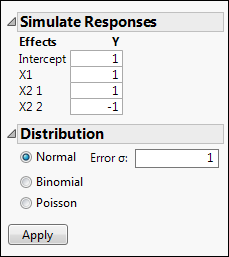Simulate Responses
Use simulated responses for exploration of a custom design prior to data collection or in a classroom setting. When simulate responses is selected and you click Make Table to create your design table, the Simulate Responses option performs the following actions:
• Adds random response values to the response column in your design table.
• Adds a new a column containing a simulation formula to the design table.
• Opens a model window that enables you to specify the simulation parameters.When you click Apply in the Model window, each column containing a simulation model formula is updated.
Model Window
Figure 4.26 shows the Model window for a design with one continuous factor (X1) and one three-level categorical factor (X2). Notice that X2 is represented by two model terms.
Figure 4.26 Simulate Responses Control Window
The initial model window shows values for the coefficients of either 1 or -1, and a Normal distribution with error standard deviation equal to 1. If you have set Anticipated Coefficients as part of Power Analysis under Design Evaluation in the DOE window, then the default values in the Simulate Responses section are the values that you specified as Anticipated Coefficients and Anticipated RMSE (Error Std) in the Power Analysis section. If it is not possible to fit the model specified in the data table’s Model script, the intercept and coefficients have default values of 0.
Simulate Responses
To specify values for the simulation, do the following steps:
1. For each term in the list of Effects, enter coefficients for the linear model used to simulate the response values. These define a linear function, L(x, β) = x‘β. See the Simulate Responses section in Figure 4.26:
– The vector x consists of the terms that define the effects listed under Effects.
– The vector β is the vector of model coefficients that you specify under Y.
2. Under Distribution, select a response distribution.
3. Click Apply. A <Y> Simulated column containing simulated values and their formula is added to the design table, where Y is the name of the response column.
Distribution
Choose from one of the available distributions in the Simulate Responses window:
Normal
Adds one or more random error terms to the linear model defined by the design and the specified coefficients. The errors are simulated from a normal distribution. Use the normal distribution for continuous responses. Enter a value for Error σ, the standard deviation of the normal error distribution. If you have designated factors to have Changes of Hard in the Factors section, you can enter a value for Whole Plots σ, the whole plot error. If you have designated factors to have Changes of Hard and Very Hard, you can enter values for both the subplot and whole plot errors. When you click Apply, the simulation formula is updated in the column <Y> Simulated.
Binomial
Simulates values from a binomial distribution.Use the binomial distribution for dichotomous responses. Enter a value for N, the number of trials. Random integer values are generated according to a binomial distribution based on N trials with probability of success 1/(1 + exp(-L(x, β)). When you click Apply, the simulation formula is updated in the column <Y> Simulated. A column called N Trials that contains the value N is also added to the data table.
Poisson
Simulates random integer values according to a Poisson distribution with parameter exp((L(x, β)). Use the Poisson distribution for count responses. When you click Apply, the simulation formula is updated in the column <Y> Simulated.
Note: You can set a preference to simulate responses every time you click Make Table. To do so, select File > Preferences > Platforms > DOE. Select Simulate Responses.
